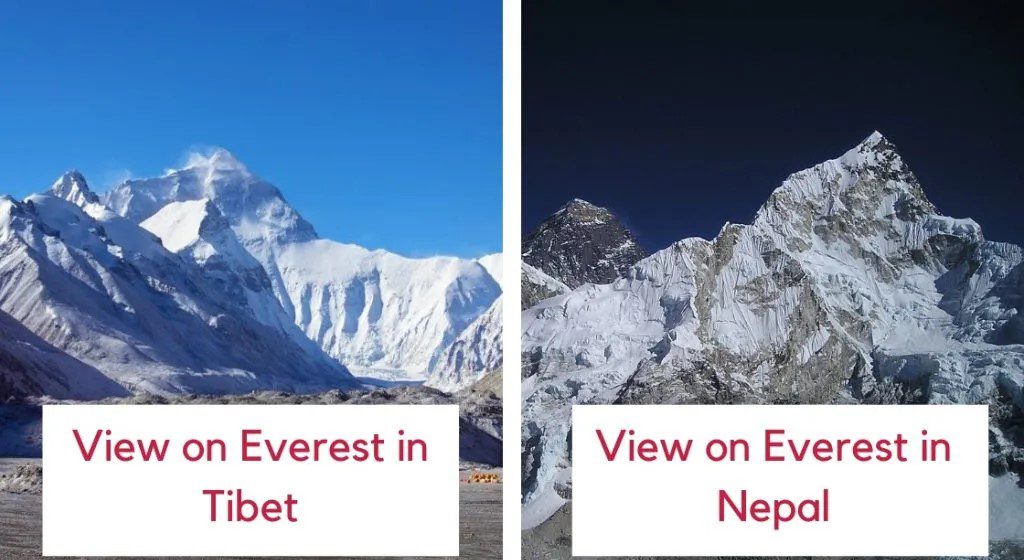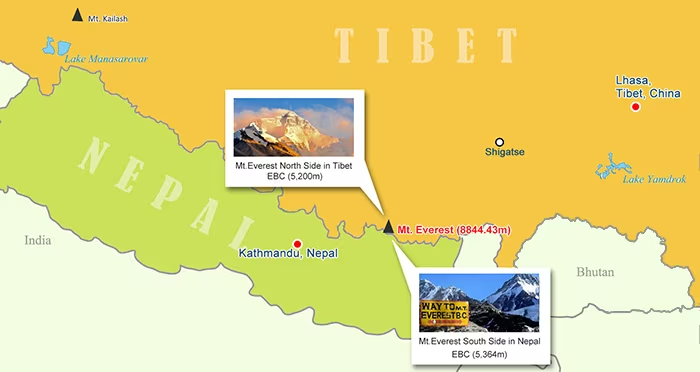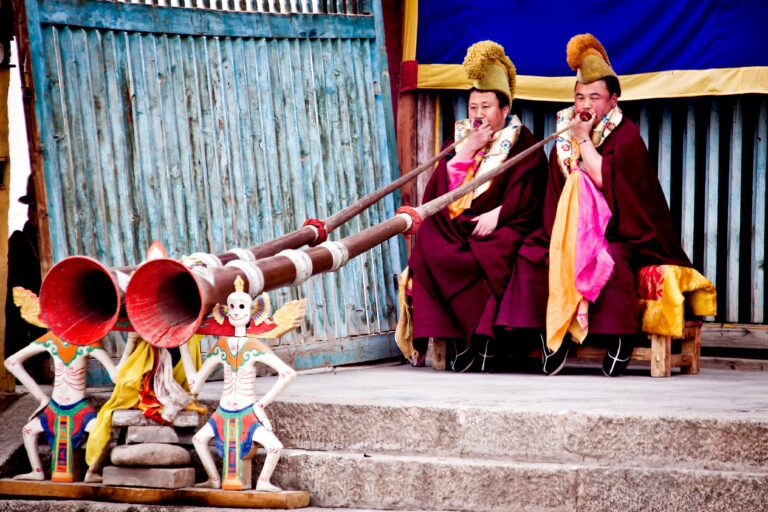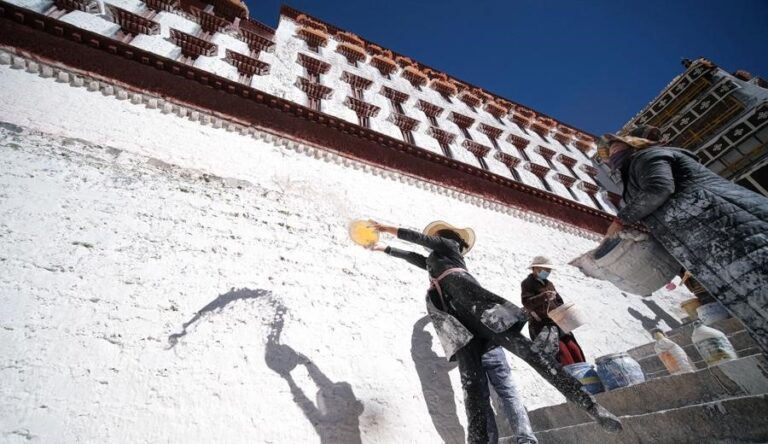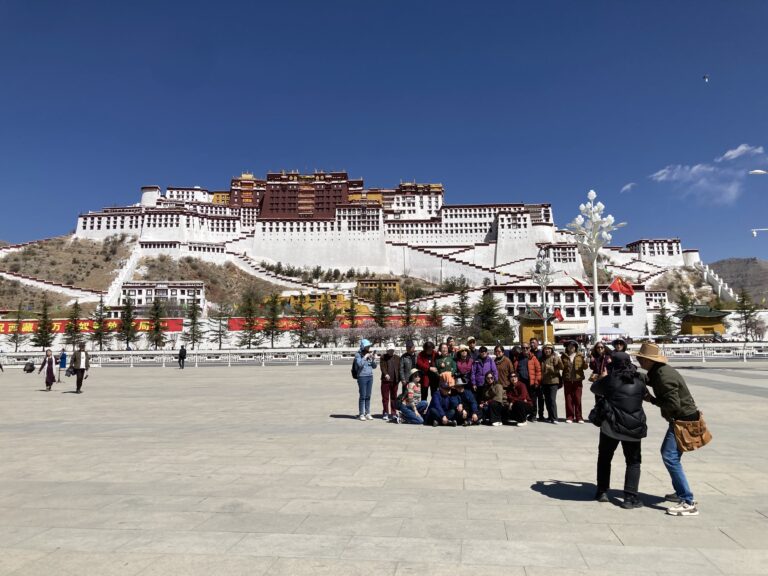Everest Base Camp (EBC) is one of the world’s most iconic trekking destinations, but did you know there are actually two main Everest base camps—one in Nepal and one in Tibet (China)?
Choosing between Everest Base Camp Nepal vs Tibet is crucial, as both routes offer unique landscapes, cultural experiences, levels of difficulty, and even proximity to Mount Everest itself. In this guide, we compare all the key aspects so you can decide which side of Everest is best for your adventure.
Overview: North Base Camp (Tibet) vs South Base Camp (Nepal)
- Nepal’s Everest Base Camp (South Base Camp):
- Located at 5,364 meters near the village of Gorak Shep.
- Start your trek with a scenic flight to Lukla and hike through the colorful Khumbu Valley villages.
- Tibet’s Everest Base Camp (North Base Camp):
- Located at 5,200 meters, accessible by overland drive from Lhasa or Shigatse.
- Known for dramatic views of Everest’s sheer north face and the high Tibetan plateau landscape.
Trekking Experience and Accessibility
Nepal Everest Base Camp Trek
- Required: Multiple-day trek (typically 12-14 days) via iconic villages such as Namche Bazaar and Tengboche.
- Accommodation: Teahouses—comfy but basic, with authentic Sherpa hospitality.
- Permits: TIMS card and Sagarmatha National Park entry are necessary (no Chinese/Tibet visa).
- Challenges: High altitude, extended hiking, but gradual acclimatization due to the trek’s length.
Tibet Everest Base Camp Tour
- Required: No trekking needed for most visitors—reach base camp with a vehicle.
- Accommodation: Guesthouses or tented camps near Base Camp.
- Permits: China visa and Tibet Travel Permit required; must book with a licensed local tour agency.
- Challenges: Less physical, but the rapid ascent demands careful acclimatization.
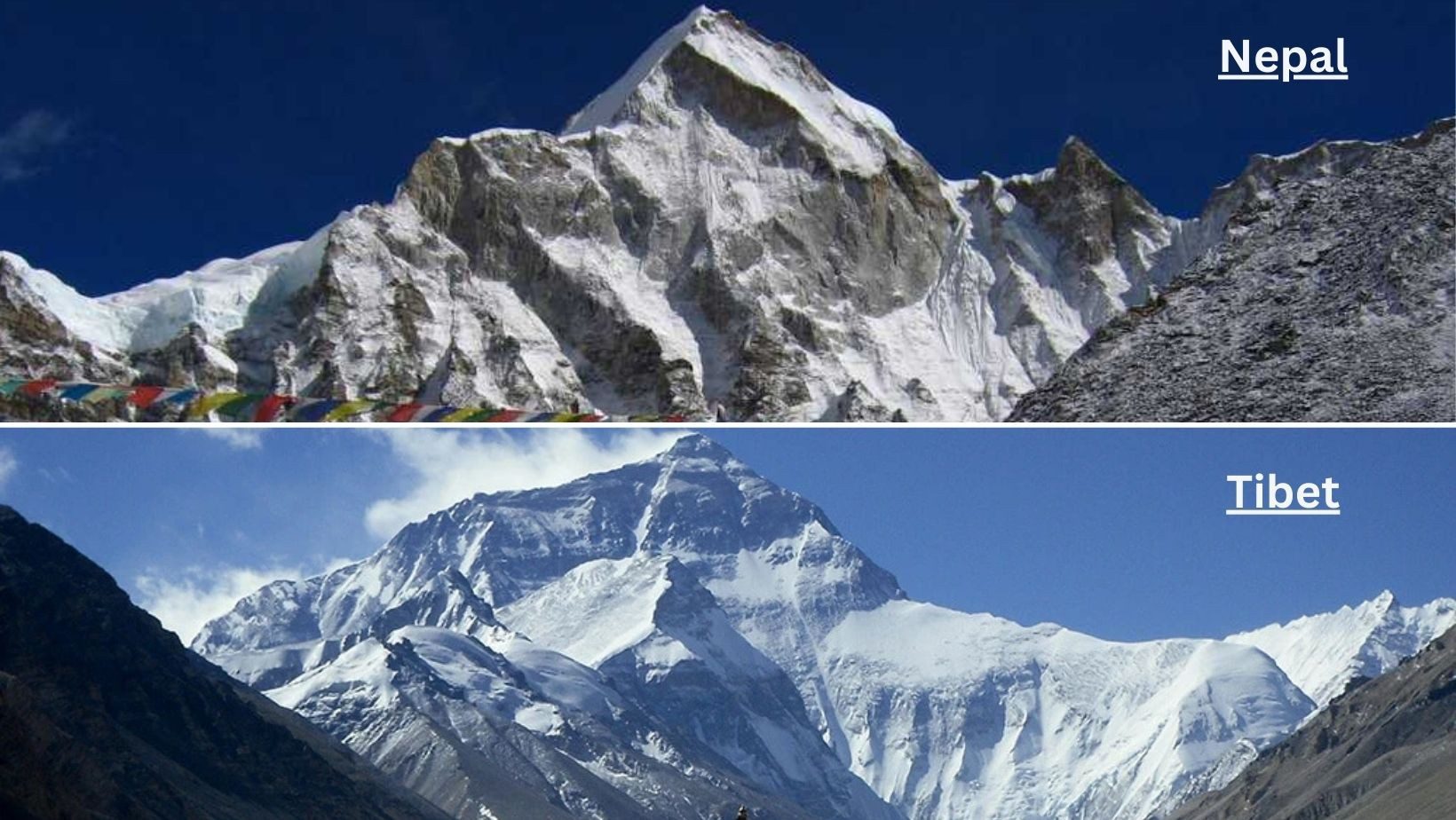
Everest Views and Scenery
- From Tibet, EBC offers a direct vista of the imposing north face—perfect for dramatic Everest photographs.
- From Nepal, trekkers arrive to a close-up southern view, but Everest’s summit is partially hidden by a shoulder peak.
- Nepal’s route is famed for lush forests, rivers, and Sherpa villages; Tibet’s for its stark, expansive plateaus and Buddhist monasteries.
Altitude and Acclimatization
- Nepal EBC altitude: 5,364m
- Tibet EBC altitude: 5,200m
- The approach in Nepal is slower, aiding in natural acclimatization. Tibet EBC offers a faster overland approach, so proper altitude preparation is essential.
Visas and Logistics
- Nepal: No visa required for major trekking nationalities at EBC. Obtain a visa on arrival for Nepal.
- Tibet: China visa and Tibet Travel Permit, plus organized tour required for all foreigners.
Best Time to Visit
- Nepal: March to May and September to November.
- Tibet: April to June and September to October.
Cost Comparison
- Nepal EBC Treks are usually less expensive and can be done independently if you wish.
- Tibet EBC Tours include permits, guides, and private vehicles, making them generally pricier.
Which Everest Base Camp Should I Choose?
- Choose Nepal if: You dream of a classic mountain trek, want to experience Sherpa culture, and desire a gradual approach by foot.
- Choose Tibet if: You prefer spectacular road trips, stunning high-altitude scenery, and the most direct close-up of Everest’s north face without long trekking days.
Frequently Asked Questions
-
Which Everest Base Camp offers a better view of Mount Everest?
Both camps offer breathtaking perspectives, but Tibet’s North Base Camp provides a more direct, unobstructed view of Everest’s iconic North Face, while Nepal’s South Base Camp gives a more immersive trekkers’ experience where Everest’s summit is sometimes partially obscured by nearby peaks. -
Is it easier to reach Everest Base Camp from Tibet or Nepal?
Tibet EBC can be reached by vehicle via a scenic overland route, requiring minimal trekking. Nepal EBC, on the other hand, is only accessible by a multi-day trek starting from Lukla. -
Do I need a guide to visit Everest Base Camp in both locations?
In Tibet, a guide is mandatory for international visitors. In Nepal, solo trekking is possible but hiring a guide is recommended for safety and local expertise. -
Which side is best for trekking lovers—Tibet or Nepal?
Nepal’s route is famous for its demanding, immersive multi-day trek through the Sherpa heartland, while Tibet is better suited for those who want to experience Everest without strenuous trekking. -
How difficult is the altitude acclimatization process on each side?
Nepal EBC trek allows gradual altitude gain over several days, helping with acclimatization. Tibet EBC’s approach is much faster, making it essential to plan rest stops and possibly medication for altitude sickness. -
What permits or visas are required for each Everest Base Camp?
Nepal EBC requires a Nepal tourist visa, TIMS, and Sagarmatha National Park permit. Tibet EBC requires a China visa and a Tibet Travel Permit, which must be arranged in advance via an authorized agency. -
Can I see monasteries and cultural sites during the journey?
Yes. On the Tibet side, you can visit iconic sites like Rongbuk Monastery, the world’s highest Buddhist monastery. In Nepal, you’ll experience Sherpa villages and famous monasteries like Tengboche. -
Which side of Everest Base Camp is less crowded?
The Tibet Base Camp is generally less crowded, especially outside of peak Chinese holidays. Nepal’s Base Camp trek is more popular among international trekkers. -
Which is more costly: Nepal EBC trek or Tibet EBC tour?
Nepal EBC is usually more budget-friendly and can be done independently, whereas Tibet EBC requires an organized tour, permits, and private transport, making it more expensive. -
When is the best time to visit Everest Base Camp in Nepal vs Tibet?
- Nepal: March–May and September–November offer the clearest weather.
- Tibet: April–June and September–October are best for clear views and comfortable temperatures.
-
Is it possible to visit both Base Camps on the same trip?
Yes, but border crossings require advance planning, multiple visas, and you’ll need to confirm the Gyirong border’s current status. Some adventure travel agencies offer trans-Himalayan tours including both sides.
- Which Everest Base Camp has the best summit views?
The North Base Camp in Tibet offers a clearer, more dramatic panorama of Everest’s true summit compared to the South Base Camp in Nepal where the summit is partly hidden. - Is it possible to reach Everest Base Camp in Tibet by car?
Yes, you can drive almost all the way to North Base Camp via the Tibet highway and a final eco-bus/WALK. Nepal’s South Base Camp can only be reached by trekking. - Is Everest Base Camp in Nepal on the North or South Side?
Nepal’s Base Camp is on the South Face of Everest (South Base Camp); Tibet’s EBC is on the North Face (North Base Camp). - Is the atmosphere different on each side?
Absolutely—Tibet offers sweeping high-altitude views and stark beauty; Nepal lets you trek through villages and forests with the mountain always in your sights.
North vs. South: Two Faces of Everest You Should Know
Mount Everest, the highest mountain in the world, can be approached from two dramatically different sides: the North Face in Tibet and the South Face in Nepal. This means the Everest Base Camp experience will vary significantly depending on which country—and which tour—you choose.
The North Side (Tibet): Everest’s Most Powerful Panorama
When you visit Everest from Tibet, you reach the famous North Base Camp at 5,200 meters. This side is celebrated for offering travelers a direct and unobstructed view of the majestic North Face, where Everest rises alone across the vast Tibetan plateau. The panorama is especially dramatic: the mountain stands tall, isolated in a horseshoe-shaped valley, dominating the skyline.
Why so many photographers, climbers, and lovers of big landscapes prefer this side:
- Easiest access by vehicle: The North Base Camp is reachable by a high-altitude paved road, so even non-trekkers and families can stand at the foot of Everest without a strenuous hike.
- Best for classic summit photos: Unlike the South Base Camp in Nepal, Tibet’s EBC allows you to fully admire the summit and all the grandeur of the world’s highest peak, making it a dream spot for photographers.
- Rongbuk Monastery: The highest Buddhist monastery in the world is nearby, adding a unique spiritual and cultural dimension to your adventure.
- Authentic Tibetan culture: Your journey passes through Lhasa, Shigatse, and villages rich in Tibetan Buddhism and tradition.
The South Side (Nepal): Trekking Adventure in the Khumbu
Nepal’s South Base Camp (EBC) sits closer to the Nepalese village of Gorak Shep, at 5,364 meters. It’s only accessible by trekking—a multi-day adventure taking you through lush forests, Sherpa villages, suspension bridges, and the foothills of the Himalaya. You’ll be “in” the mountains for days, and the atmosphere is legendary among trekkers worldwide.
- Everest Summit view: From South Base Camp, Everest’s actual summit is partially obscured by the huge shoulder of the mountain (Nuptse and Lhotse). For the famous summit panorama, trekkers often hike to Kala Patthar, an extra climb nearby.
- Who should choose this? Trek lovers looking for adventure, local homestays, and the full trekking experience.
Why Choose the Tibet (North) Side for Your Everest Tour?
- Superior View: The North Base Camp in Tibet offers the best, clearest, most dramatic face of Everest. You’ll be able to capture iconic photos of the summit itself, set against the sweeping emptiness of the Tibetan plateau—a stark contrast to the more congested Khumbu valley in Nepal.
- Easy yet high adventure: The North Base Camp is accessible by vehicle, allowing more people (including families and those not suited to trekking) to experience Everest up close.
- Comfort, safety, and culture: Experience Tibet’s 8-day Everest Base Camp Tour ensures comfortable overland travel, top logistics, and immersion in the culture of Tibetan Buddhism.
- Unique highlights: Opportunities to visit places like Rongbuk Monastery, enjoy Tibetan hospitality, and witness the mountain as only the legendary northern expeditions have.
Experience Everest’s North Face the Easy Way
If you want to see the world’s most iconic mountain in its purest form—and without a long trek—choose our 8-Day Everest Base Camp Tour in Tibet. You’ll enjoy unmatched summit views, Tibetan hospitality, and a once-in-a-lifetime journey through Himalayan culture and landscapes.
Conclusion
No matter which Everest Base Camp you choose, you will have a once-in-a-lifetime experience. Both sides offer unique perspectives of the “Roof of the World”—just remember to plan carefully around permits, acclimatization and your fitness level. Everest Base Camp Nepal vs Tibet: the adventure is yours to make!


